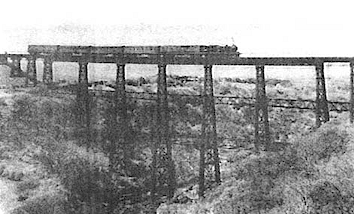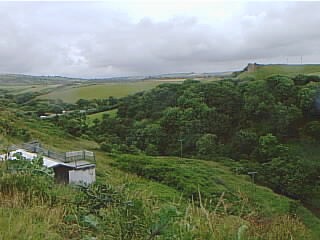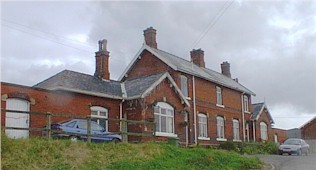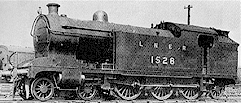In 1866 the Whitby, Redcar and Middlesbrough Union Railway Company was formed and by 1873 had surveyed the land and obtained an Act of Parliament to build a railway from Middlesbrough to Whitby via Loftus, Grinkle, Staithes, Hinderwell, Kettleness (Yorkshires most remote village), Sandsend and Whitby West Cliff.
This was to be an challenge with steep gradients and tunnels through unstable rock but this was the age of the Victorian Engineer. The railway, that still exists, north of Staithes is not particularly spectacular as it winds its way to the modern Boulby Potash Mine. Here the railway now terminates but it used to cross the A174 by the junction of Cow Bar Lane and then over the 150ft deep valley of the beck via a 700 ft long iron and concrete viaduct built in 1875.

Staithes Viaduct complete with the typical 5 carriage train used on this route
Image by Unknown Photographer
The engineering of the time suffered a disastrous set back with the collapse of the Tay Bridge in 1879. This was a year of bad weather. Heavy snow and high winds delayed building works along the rest of the line. It was not until 1883 that the viaduct was eventually strengthened and the line opened to traffic.
The viaduct was totally exposed to the North Sea gales and one can imagine crossing over in a high wind would have been quite an experience. In any kind of wind a 20 mph restriction was imposed on trains crossing the viaduct and when the gales blew traffic was halted. A bell was rung to indicate that the winds were too strong, the viaduct has gone but the bell is preserved in the National Railway Museum in York.
The northern parapet of the viaduct still exists and can be seen in the top right corner of the photograph below but the iron work has long gone. The site of the southern parapet has been levelled and is now occupied by the main public car park for the town.

All that is left of the Staithes Viaduct
Image by John Vincent dated: July, 2004
Immediately to the south of the viaduct and high above the old town of Staithes lies the station building, today a rather imposing private house

The front aspect of the Old Railway Station at Staithes
Image by John Vincent dated: July, 2004
The station was served by the Station Hotel a few hundred yards away, this too still exists as the Captain Cook Inn.
In 1889 the Whitby, Redcar and Middlesbrough Union Railway was taken over by the North Eastern Railway Company and it to was absorbed into the London and North Eastern Railway Company in1923.

A LNER B17 4-6-0 Locomotive of a type once used at Staithes
Image by Unknown Photographer

A LNER A8 4-6-2 Tank Engine of a type once used at Staithes
Image by Unknown Photographer
The line continued on to Whitby via Hinderwell and the other villages in places hugging the cliff top and in others through tunnels and over steep gradients especially at Kettleness. This was a line not loved by the engine men, it was extremely exposed and engines prone to stalling and slipping on the wet or icy rails. This line required powerful engines the B17 Pacific had a tractive effort of 25,000lbs and typically hauled seven or eight coaches whilst the smaller A8 Tank with an tractive effort on 23,000lbs usually hauled a rake of five coaches. For more details about the L.N.E.R. check out the London & North Eastern Railway (LNER) Encyclopedia
By 1958 the Whitby end of the line closed to traffic and in April 1960 Staithes Station was closed and the viaduct dismantled